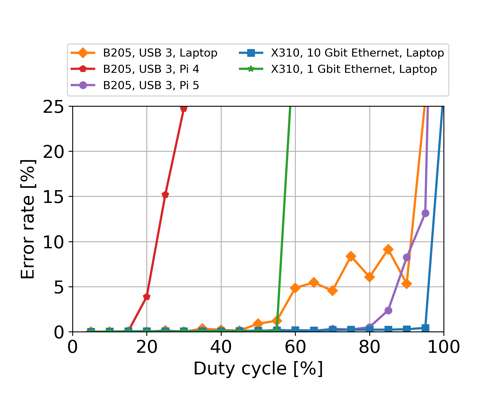Host computer transport parameter tuning
The maximum duty cycle you can achieve is a function of the SDR you use, the host computer, and the bandwidth you need. This page outlines suggestions for how to figure out an achievable duty cycle and what parameters can be tweaked to maximize this.
General process for benchmarking duty cycle
Determine the maximum achievable bandwidth with benchmark_rate
Use the USRP example benchmark_rate program (located at
<path to conda install>/envs/<uhd environment name>/lib/uhd/examples) to
determine the approximate maximum duty cycle you can achieve. For instance, with
a Pi 4 and b205mini, I can reach about a 25% duty cycle – defined as sample
rate divided by desired sample rate (14 Msps / 56 Msps in this case) – while
consistently getting 0 dropped packets.
./benchmark_rate --tx_rate 14e6 --rx_rate 14e6 --tx_otw sc12 --rx_otw sc12 --args="num_recv_frames=512,num_send_frames=512,recv_frame_size=16000,send_frame_size=16000"
This is also the stage to experiment with what transport parameters allow for the highest throughput on your combination of computer/interface/SDR. However the choice of (send/recv)_frame_size should be based on the number of samples per chirp and won’t have the same kind of impact in this continuous streaming case. In other words, you can get close but more tweaking later will help – probably.
Read about USB transport parameters on the Ettus website.
Figure out desired pulse lengths (RX and TX) and set frame sizes appropriately
Basically you want one full set of received samples to fit in a frame. See many more details about this in “Transport layer - throughput limitations” below.
Run tests/error_code_late_command_sweep.py to figure out your max duty cycle
This will sweep across effective duty cycles from 100% to 1, testing the
equivalent pulse_rep_int for each one. The script produces a plot (saved as
error_code_late_command.png) that shows percent of errors versus duty cycle.

Example results from running error_code_late_command_sweep.py on several
combinations of host computers and SDRs.
Tuning transport parameters
In addition to getting late commands, the other issues we can run into are overflows (D on network-based devices, O on other devices) and underflows (U on all devices). There are also sequence errors (S) that often go along with late commands (L). Overflows mean that the buffers filled up and samples from the SDR are not being consumed fast enough. Underflows mean that the SDR did not receive samples to transmit before it needed to transmit those samples.
The Ettus knowledge base has a page detailing theoretical maximum transfer rates for each device.
Depending on the device, data is transferred over USB using libUSB, GigE, 10GigE, or PCI-E. For each option, there are various tunable parameters that impact the packet sizes and buffers used.
For libUSB, the transport parameters are:
(send/recv)_frame_size is the maximum packet payload size in bytes. The
maximum number of samples that fits into a packet is <packet size in bytes>/<bytes per sample>.
The bytes per sample is determined by the over-the-wire format
(see otw_format).
For example, sc12 requires 24 bit/samples, which is 3 bytes. It’s named sc12
because each value is 12 bits, but there are two values per samples (I, Q).
You can query the max number of samples based on your selected
(send/recv)_frame_size through the TX or RX streamers:
tx_stream->get_max_num_samps() or rx_stream->get_max_num_samps()
The default is around 8 MB (on my laptop and on the Pi 4B, both running Ubuntu-derived variants). If you set it too high, you’ll get an error message.
In most cases one full chirp (TX) or the received samples associated with one full chirp should fit and a good choice is to set the frame sizes to be equal to (or just barely larger than) the expected number of TX and RX samples, respectively, per chirp.
num_(send/recv)_frames controls how many buffers of size
(send/recv)_frame_size are created. The more buffers you allocate for
receiving, the longer your host program can lag for before causing an overflow.
LibUSB will give you a memory error if you try to allocate too much memory overall (roughly frame size * number of frames).
This is also why you don’t want arbitrarily large frame sizes. You end up wasting RAM if you’re allocating buffers that are longer than the maximum packet size you expect.
num_recv_frames is one of the most commonly talked about points on the USRP
mailing list for throughput issues on the b2xx devices. Apparently the default
value is very small (though I wasn’t able to figure out how to find the actual
default).
You set these parameters in the device arguments string. For us, that means something like this in the config YAML:
device_args: "num_recv_frames=700,num_send_frames=700,recv_frame_size=11000,send_frame_size=11000"
As described above, the USRP example program benchmark_rate is very useful for playing with these parameters quickly and figuring out what the limits are.
The host side matters a lot here too. The amount of RAM available on the host
directly limits the num_(send/recv)_frames. Processing speed of the host in
general can easily be the bottleneck. Finally, some USB 3.0 controllers are
known to work better than others. The Ettus knowledge base used to have a table
of performance on a few selected USB controllers. An archive of that page is
available here.
(The Pi 4 uses a VL805 controller. The Pi 5 has a new USB controller that performs far better.)